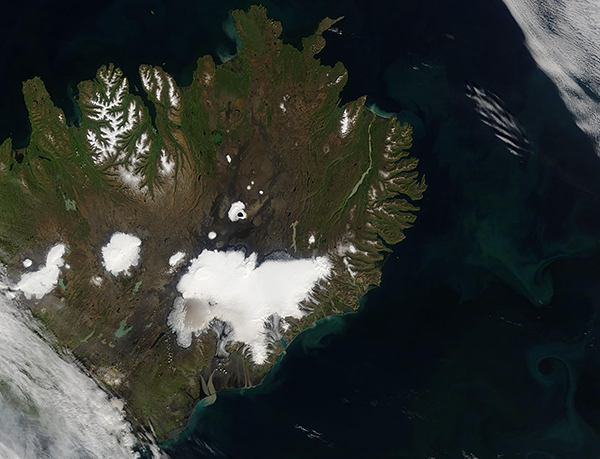Images
August 9, 2022 - Summer in Iceland
Tweet
On August 5, 2022, the clouds layer that frequently covers Iceland parted, allowing the Moderate Resolution Imaging Spectroradiometer (MODIS) on board NASA’s Aqua satellite to acquire a gorgeous true-color image of a sunny Icelandic summer day.
True to its name, Iceland’s winters are long and snow-laden. However, the island’s location and relatively gentle maritime climate, summers are warm enough to melt all except about ten percent of the country’s winter coat of white. This ten percent of the country remains covered with year-round glaciers and ice caps.
The largest ice cap Vatnajökull, is located near the southeast coast and is truly spectacular. It stretches over an area of 3,127 square miles (8,100 square km), which is slightly larger than the size of the U.S. states of Delaware and Rhode Island combined. About 30 outlet glaciers flow from Vatnajökull’s ice cap. One of these long glaciers is Breidamerkurjokull, which ends in Jokulsarlon glacial lagoon. This lagoon can be seen off the southeast section of Vatnajökull.
Two smaller ice caps Langjökull and Hofsjökull can be seen in the central highlands. Snow and glaciers also sit in the highlands of northwest Iceland. The cold currents flowing off the shores tend to keep the northwestern section of the country colder than the rest of the island.
A gray area in the southwest section of Vatnajökull is atypical and appears to be caused by recently-deposited dust and sand. In July 2022, the white cap was suddenly stained with gray and brown. How the color got there is not quite what you would expect on a damp, icy island.
Ash from volcanic eruptions has darkened Vatnajökull periodically in the past. But in July 2022, the volcanoes of Iceland were all quiet. Instead, windstorms likely lofted sand and mineral dust from the ground onto the ice cap. Scientists have estimated that about 4.5 million tons of dust comes to rest atop Iceland’s glaciers each year.
Iceland’s climate is not hot or dry, but it can still be a dusty place. On average, the country sees 135 “dust days,” in which at least one weather station on the island detects dust. Much of it comes from heavily eroded areas at the fronts of glaciers, but also from sandy deserts. Together these dusty surfaces cover nearly a quarter of the country.
The abundant dust and frequent strong winds result in several significant dust storms each year. Some of the particles are lofted all the way to Greenland and its ice sheet. Much of it stays local to Iceland. Thin layers of dust can reduce the amount of light that the ice cap reflects back to space—leading to a cascade of effects, including melting. In contrast, thicker layers of ash can actually insulate the ice from melting.
Image Facts
Satellite:
Terra
Date Acquired: 8/5/2022
Resolutions:
1km (157.7 KB), 500m (459.4 KB), 250m (1.1 MB)
Bands Used: 1,4,3
Image Credit:
MODIS Land Rapid Response Team, NASA GSFC
Tweet
On August 5, 2022, the clouds layer that frequently covers Iceland parted, allowing the Moderate Resolution Imaging Spectroradiometer (MODIS) on board NASA’s Aqua satellite to acquire a gorgeous true-color image of a sunny Icelandic summer day.
True to its name, Iceland’s winters are long and snow-laden. However, the island’s location and relatively gentle maritime climate, summers are warm enough to melt all except about ten percent of the country’s winter coat of white. This ten percent of the country remains covered with year-round glaciers and ice caps.
The largest ice cap Vatnajökull, is located near the southeast coast and is truly spectacular. It stretches over an area of 3,127 square miles (8,100 square km), which is slightly larger than the size of the U.S. states of Delaware and Rhode Island combined. About 30 outlet glaciers flow from Vatnajökull’s ice cap. One of these long glaciers is Breidamerkurjokull, which ends in Jokulsarlon glacial lagoon. This lagoon can be seen off the southeast section of Vatnajökull.
Two smaller ice caps Langjökull and Hofsjökull can be seen in the central highlands. Snow and glaciers also sit in the highlands of northwest Iceland. The cold currents flowing off the shores tend to keep the northwestern section of the country colder than the rest of the island.
A gray area in the southwest section of Vatnajökull is atypical and appears to be caused by recently-deposited dust and sand. In July 2022, the white cap was suddenly stained with gray and brown. How the color got there is not quite what you would expect on a damp, icy island.
Ash from volcanic eruptions has darkened Vatnajökull periodically in the past. But in July 2022, the volcanoes of Iceland were all quiet. Instead, windstorms likely lofted sand and mineral dust from the ground onto the ice cap. Scientists have estimated that about 4.5 million tons of dust comes to rest atop Iceland’s glaciers each year.
Iceland’s climate is not hot or dry, but it can still be a dusty place. On average, the country sees 135 “dust days,” in which at least one weather station on the island detects dust. Much of it comes from heavily eroded areas at the fronts of glaciers, but also from sandy deserts. Together these dusty surfaces cover nearly a quarter of the country.
The abundant dust and frequent strong winds result in several significant dust storms each year. Some of the particles are lofted all the way to Greenland and its ice sheet. Much of it stays local to Iceland. Thin layers of dust can reduce the amount of light that the ice cap reflects back to space—leading to a cascade of effects, including melting. In contrast, thicker layers of ash can actually insulate the ice from melting.
Image Facts
Satellite:
Terra
Date Acquired: 8/5/2022
Resolutions:
1km (157.7 KB), 500m (459.4 KB), 250m (1.1 MB)
Bands Used: 1,4,3
Image Credit:
MODIS Land Rapid Response Team, NASA GSFC




